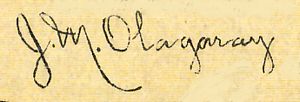Bonos of the Asociación Durangueña
In the beginning the rebels extorted forced loans from merchants and other well-to-do citizens, many of whom had all their wealth in lands and buildings. As these properties could not be readily sold, a group of businessmen, who called themselves the Asociación Durangueña, made another suggestion.
On 29 July 1913 the Association agreed a contract with Manuel del Real Alfaro, the Director General de Rentas del Estado, for an issues of bonds (bonos). These 100,000 pesos, in denominations of 50c, $1 and $5, were to be used to overcome the shortage of small change and to pay for the costs of war; they were to be local, of forced circulation and unlimited duration, until the restoration of peace when they would be redeemed in cash. The Association underwrote the issue with properties. Anyone who needed bonos could purchase them from the Tesorería in exchange for merchandise or stock. This contract was ratified by the provisional governor, Pastor Rouaix, on 31 July, who declared the notes of forced circulationPeriódico Oficial, Durango, Tomo XXXVIII, Núm. 54, 17 August 1913.
The Asociación Durangueña set up an office in the Palacio del Gobierno which opened to the public on 16 August, and the notes began to circulateEl Demócrata, Durango, Segunda Época, Tomo II, Núm. 2, 17 August 1913. On 1 September it was reported that the $1 and 50c notes had been issued but the $50,000 in $5 notes had not yet been put into circulationThe Mexican Herald, 18th Year, No. 6,575, 1 September 1913.
The first fine for refusing to accept the bonos was levied a couple of days laterEl Demócrata, Segunda Época, Tomo II, Núm. 7, 4 September 1913.
On 13 September, because of the shortage of small change, Rouaix agreed that the Association could replace $5,000 in $5 notes with a similar amount in 20c notes, so there were four different valuesPeriódico Oficial, Durango, Tomo XXXVIII, Núm. 57, 21 September 1913.
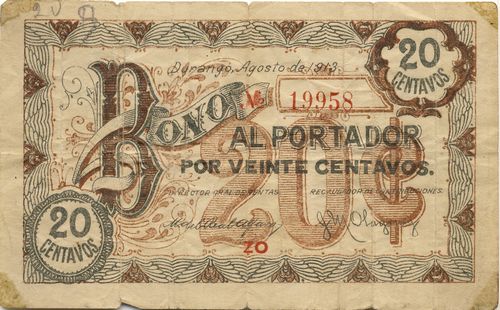
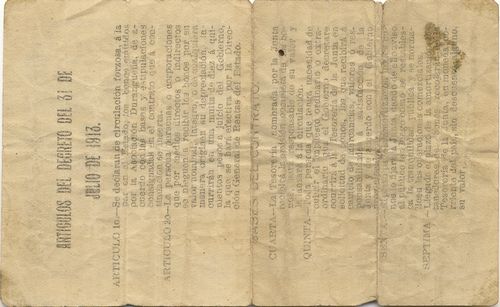
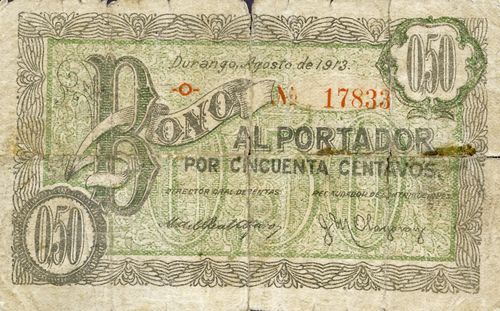
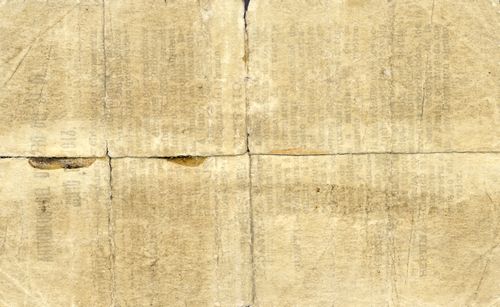
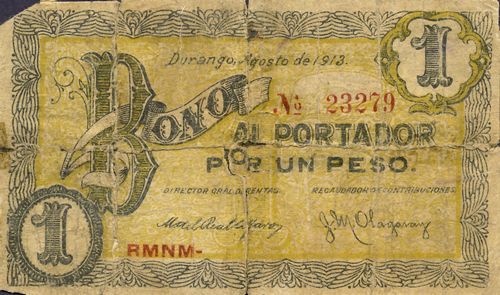
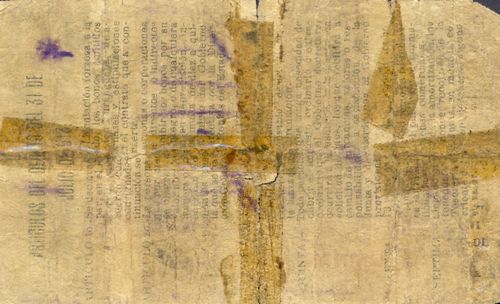
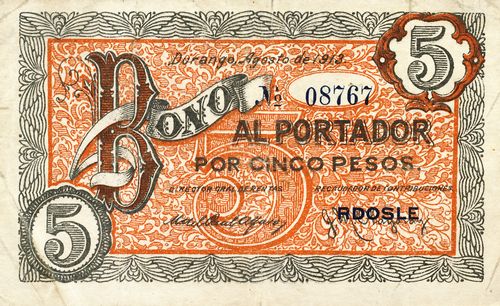
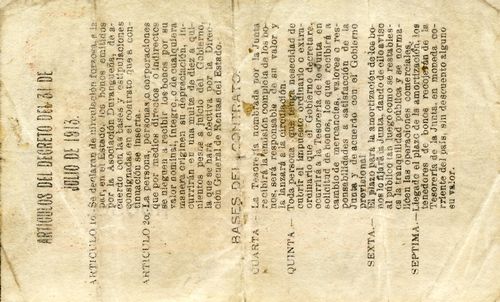
These notes have red code letters.
| from | to | total number |
total value |
code |
||
| 20c | ZO | includes number 19958 | ||||
| 25,000 | $ 5,000 | |||||
| 50c | IDZ | |||||
| -O- | includes number 17833 | |||||
| A-A | includes number 18467CNBanxico #10879 | |||||
| 90,000 | 45,000 | |||||
| $1 | NENS- | |||||
| RMNM- | includes number 23279 | |||||
| E-ITG- | includes number 24754CNBanxico #10880 | |||||
| VLOD- | ||||||
| $5 | UDIE | vertical | ||||
| OERL | includes number 00964 | |||||
| EONQ | includes number 04431CNBanxico #10881 | |||||
| RDOSLE | includes number 08767 | |||||
| $100,000 |
These notes carried the signatures of Manuel del Real Alfaro as Director General and Juan M. Olagaray as Collector of contributions (Recaudor de Contribuciones). On the back they carried the first two articles of the 31 July decree and four clauses from the agreement with the Association.
After a meeting with more than 30 businessmen on 2 October the Director de Rentas agreed a second issue of $100,000 in 20c, 50c and one peso notesEl Demócrata, Segunda Época, Tomo II, Núm. 19, 16 October 1913. They were of the same design but have the overprint ‘2a. Emision’, and the new date on the face and reverse.
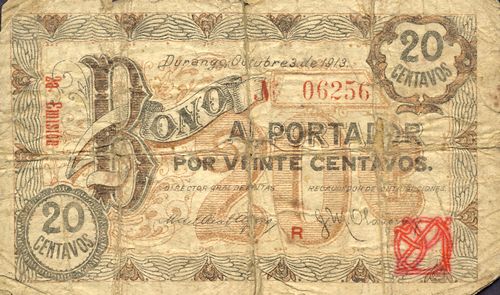
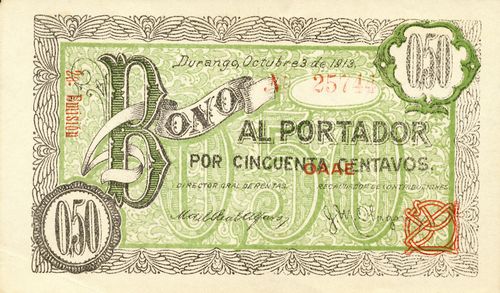
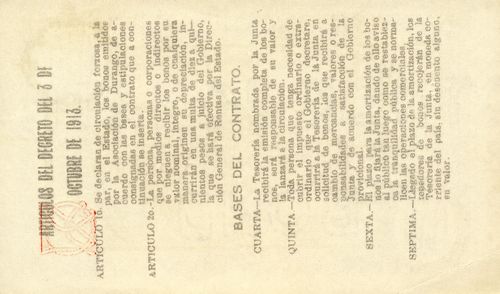
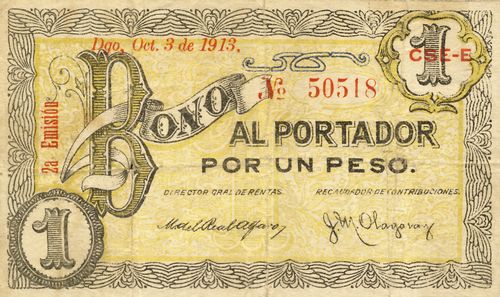
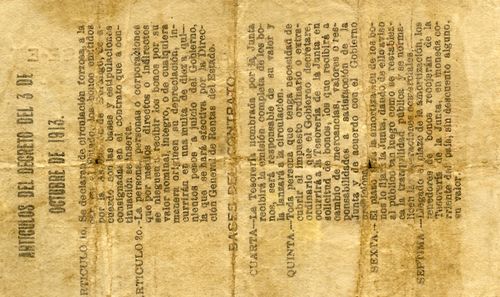
Again, these notes have red code letters.
| from | to | total number |
total value |
code |
||
| 20c | R | 'knot' overprint includes number 06256 |
||||
| U | 'knot' overprint | |||||
| C | 'knot' overprint includes number 31345CNBanxico #10882 |
|||||
| 50c | OAAE | 'knot' overprint includes numbers 25744 and 25761CNBanxico #10883 |
||||
| $1 | EOPR | |||||
| RFTA | ||||||
| IURN | includes number 15200 | |||||
| IEQI | vertical includes number 37144CNBanxico #10884 |
|||||
| T-N-UD- | vertical includes number 42182 |
|||||
| CSE-E | includes number 50518 | |||||
| $100,000 |
All these new notes were in circulation by 16 OctoberEl Demócrata, Segunda Época, Tomo II, Núm. 19, 16 October 1913.
On 18 October 1913 the Jefe de Armas, Severino Ceniceros, and Presidente Municipal of Torreón, Ciro M. Santelices, added these Durango notes to those in forced circulation in the townPeriódico Oficial, Durango, 6 November 1913.
For the future history of the acceptance of these notes see the section 'Villista attacks on 'Carrancista' issues'.
La Imprenta de Miguel Gómez
The Imprenta de Miguel Gómezinformation and images from Jesús Manuel Ceceñas González, La producción gráfica de la familia Gómez en Durango, 1861-1922: alcances técnicos y valores estéticos, Universidad Juárez del Estado de Durango, November 1921, in the Portal de Santa Saría, had been established by Miguel Gómez Vázquez by 1861. He had been born in Durango, on 28 October 1858 had married Maximiana Olave, and died of broncopneumonia on 7 April 1871. Two of his sons. Miguel and Carlos Gómez Olave, took over the printing business.
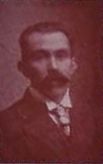 Miguel Gómez Olave was born in 1859. Although his father and brother had knowledge of techniques such as drawing, engraving and printing, Miguel was especially influenced by an artistic approach to the creation of graphic and pictorial products. . In 1874 the workshop known as the Litografía y Tipografía de Miguel Gómez began operations. From 1905 Miguel was also in charge of the new Imprenta del Estado which the then governor, Esteban Fernández, established in the Penitenciaría.
Miguel Gómez Olave was born in 1859. Although his father and brother had knowledge of techniques such as drawing, engraving and printing, Miguel was especially influenced by an artistic approach to the creation of graphic and pictorial products. . In 1874 the workshop known as the Litografía y Tipografía de Miguel Gómez began operations. From 1905 Miguel was also in charge of the new Imprenta del Estado which the then governor, Esteban Fernández, established in the Penitenciaría.
Miguel’s own son, Xavier, worked with his father in the 1910s though he has studied book-keeping at the Instituto Juárez and went on to be contador and cajero for the Banco de Durango.
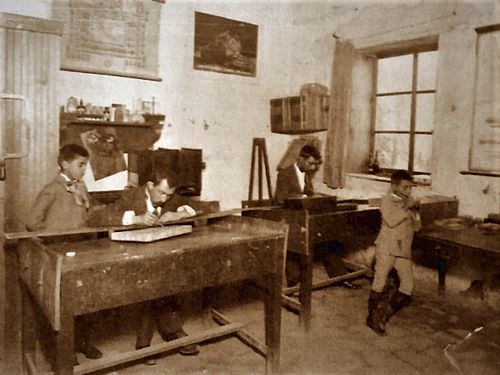
Miguel Gómez Olave’s workshop. On the left is Miguel Gómez Olave at work. The children are his two sons, Xavier and Emilio Gómez Márquez
(source: private collection of Carlos Sánchez Gómez).
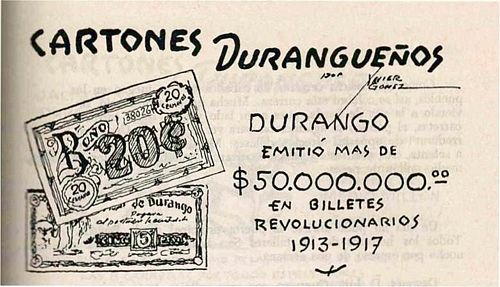

Miguel Goméz’ printing press (the reference to $50,000,000 is no doubt excessive but Miguel's son, Xavier, repeats it)
On 18 June 1913, when a group under the command of Domingo Arrieta, Calixto Contreras, Tomás Urbina and Matías Pazuengo took the city of Durango, Gómez’ family home was sacked.
The first notes that Miguel Gómez produced were the Bonos of the Asociación Durangueña. He went on to produce notes for Pastor Rouaix, Domingo Arrieta, Emiliano Sarava and Máximo García.
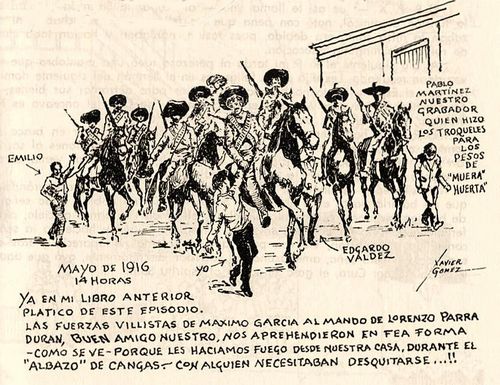
This cartoon from Xavier Gómez, commenting on the indiscrimate issue of notes, illustrates an incidence in May 1915 (not 1916) when Villistas forces under the command of his good friend, Lorenzo Parra Durán, arrested him. Xavier, his brother Emilio and the engraver (grabador) Pablo Martínez, who is claimed to have made the dies for the Muera Huerta pesos, were taken by Máximo García’s troops to his headquarters where they were held along with other prisoners considered insurrectionists until General Emiliano G. Sarabia pleaded on their behalf and managed to free them. Carlos Sánchez Gómez recalled that the family remained locked inside their house when the situation was dangerous, and since the confinements could last for days, the members of the family tried to entertain themselves with board games.
The end of the workshop's participation occurred after a disagreement between Xavier and Emilio Gómez with the Villista forces during 1915. It is assumed that Francisco Villa summoned the two brothers to demand they print notes for his side. At a certain point, Villa expressed his intention to take both the printing press and its managers to Chihuahua so that they could supply the money that was needed, but according to Xavier Gómez, both he and his brother managed to escape thanks to the fact that they hid in the house of an acquaintance while the Villista troops had to make a hasty departure from the city of Durango. However, according to Carlos Gómez Sánchez, Villa did manage to steal machinery from them and left them in ruins, a situation that resulted in the eventual move of the family to Mexico City in the early twenties.


